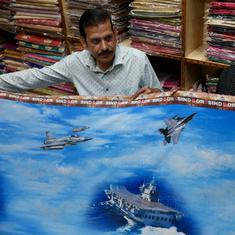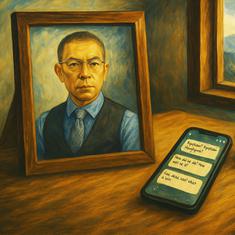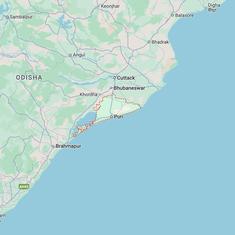I expected the archives of the Victoria and Albert Museum to be in the back rooms of the museum’s red-bricked building in central London, where grand, arched doorways and vaulted, painted ceilings inspire a sense of reverence and awe. But once I arrived in the swampy summer London heat, I realised that the storage facilities for the V&A instead were housed in the posh western suburbs of the city, in a castle-sized building that was once the former headquarters of the Post Office Savings Bank. The V&A has one of the best garment collections in the world, and I’d come to look at their bustle collection to see if I could do what Jules Prown suggests is possible: peer into the unconscious of the past.
The receptionist at the front desk asked me to deposit my things in a small locker before directing me toward a long wooden bench. Other researchers – coiffed women in suit jackets – soon joined, waiting patiently for their turn to pass through the metal door that opened into vast reserves of bones and dolls and furniture, the overflow collection of the V&A, the British Museum, and London’s Science Museum. One by one we left with our designated archivists, our locker keys attached to our wrists with rubber cords, like women at a spa on the way to a massage.
My assigned archivist, Saranella, introduced herself, and together, we rode an elevator to an expansive, high-ceilinged room filled with white floor-to-ceiling racks containing hundreds of still lifes, portraits in gilded frames, and shelves of objects wrapped in white, acid-free paper. Rows of mannequins stood haphazardly, their heads shrouded in white netting, their bodies cloaked with Tyvek, a plasticky white cloth that was used to protect the clothing from light and humidity. They looked like medieval maidens, covered and faceless, billowy and beautiful. A photograph pinned to each revealed the dress or petticoat stored beneath the synthetic covering.
When we arrived at my designated viewing space, Saranella directed me to three large tables covered in white archival paper where the garments I’d asked to view were laid out. There were no mannequins, only disembodied cloth lying flat and lifeless on the table. The pouffes sagged, the fringe sat still.
The first bustle I inspected was a patterned maroon cushion with multiple stuffed oval lobes of varying sizes. It tied at the waist with simple white tape, and the pillows cascaded behind to create the desired gluteal lump.
The second had a vaguely steampunk, S-and-M vibe. Made of now-rusty steel bands fastened together, it once would have opened and closed at a hinge to create the illusion of an almost triangular rear end. The third was made of stiffened white fabric that laced on the underside to create a pouffe. The tighter the wearer cinched the laces, the more pert the butt became.
I’d come to the archive armed with a working knowledge of the basics: the first bustles, or proto-bustles, were small pads of cotton that women strapped to the small of the back to prevent the fabric from clinging to the body. They came to prominence during the Regency era – the period immortalised by Jane Austen – when dresses were relatively comfortable, Grecian-inspired shifts. Women wore only a few layers of petticoats, and most didn’t even wear underwear unless they were riding a horse.
The bustle emerged as a way to keep the fabric from getting stuck between the legs and creating what was, essentially, a wedgie. The simplicity didn’t last long – by the 1840s, women were wearing enormous bell-shaped skirts with an undergirding infrastructure of petticoats. Underneath a woman’s taffeta dress, she would have worn layer upon layer of cotton skirts, heavy and hot, designed to puff out and show the luxurious, expansive fullness of her gown.
Wearing lots of petticoats meant a woman could afford lots of petticoats – as is often the case in fashion, the skirts were a symbol of wealth. Eventually, women made the switch to crinolines – petticoats made of horsehair, whalebone, and, later, steel – which made clothing lighter and cooler and allowed skirts to grow bigger. By the 1850s, skirts were so enormous that women often couldn’t walk through doorways.
Enter the bustle.
Popularised in 1868, it grew larger and more bulbous in the early 1880s. The simplest bustles were nothing more than pillows stuffed with cotton or horsehair buckled around the waist. Later, as materials advanced and manufacturers tried to find new ways to sell their products, bustles grew more complicated. Some utilised an accordion-style design that folded up beneath a woman as she sat down, others made use of a swollen mesh bolster or a complicated arrangement of springs. The undergarment transcended class – some women simply stuffed their dresses with newspapers (the London Times was said to be the best choice) or flounced their petticoats and pinned them up in the back, similar to the way many brides do today. Even little girls wore them.

The garments on the table in front of me at the V&A were examples of the bustle from different eras, and each seemed to present a different set of problems for the wearer. The pillowy one seemed like it might easily shift, its bulge drifting hipward to undermine the big-butted illusion. The bustle whose girth was created by stiffened fabric appeared delicate and easy to crush, and while the accordion bustle appeared sturdy, it threatened malfunction, leaving the wearer in the lurch if it refused to open or close.
In addition to the bustles themselves, I’d also asked to see an example of the dresses that a woman would have worn on top of them. The one that lay on the table before me was an expensive, bright purple creation, fussy and fancy, its skirt designed with ample room for a bustle. I found myself almost jealous – how often had I raged that no skirt or pair of pants in the world would accommodate a large butt? And yet, here were garments made entirely for that purpose, at least in a sense. Eager to see how these objects might transform the shape of a body, I asked Saranella if it might be possible to put the bustles and dresses on a mannequin. Her eyes widened. “Oh no, oh no,” she said.
I realised she had misunderstood my question, thinking that I wanted to slip into one of the dresses myself – dresses that I had been forbidden to touch. The misunderstanding made me imagine my own body wrapped in one of the enormous dresses, a silk collar up to my chin and a silk hem down to my ankle, a cushiony protrusion tied to my rump. I thought of the hot, cumbersome material of all those skirts, the punitive straightness of a laced-up corset trapping my fleshy torso, the boning and caging and ties digging into my softest parts. I imagined having to reach down and pull on the accordion bustle to unfurl it when I stood up, grabbing at my butt as I rose up out of my chair. A woman must have been forever adjusting and poking around her backside, yanking at her bustle and doing battle with its various components. Even when she was seated, there’d be no rest in it.
Although the bustle is relatively under-studied by fashion historians compared to other 19th-century garments, there are various theories for why it became so popular. Some posit that it’s nothing more than an extension of the corset, believing that women who wore them weren’t interested in largeness, but rather smallness: a large bottom highlights a small middle, and it is of course a small middle that women most wanted. There is an assumption in this logic that women have always primarily wanted small waists, despite the fact that a small waist also can make a butt look bigger.
Another theory suggests that we shouldn’t think of the bustle as a butt enlarger so much as a streamlined crinoline – skirts had grown ridiculously large by 1870 and the bustle may have been a practical solution to a common problem: bunch all those skirts up in the back so a woman could successfully find her way through a door. There are also materialist theories about the rise of the bustle. The first Industrial Revolution in the late 18th century had made fabric widely available, and by the 1870s and 1880s, the invention of the sewing machine made it much faster for women to make their own clothes, a development that greatly worried professional dressmakers. Not only could women sew dresses themselves, they also came to know just how much the materials cost, inviting them to wonder why they were paying vastly more than the cost of fabric to have a dress made. In a canny response, dressmakers decided to prove their worth, adding the complicated seams and flourishes that comprise a bustle.
In that way, a bustle also became a sign of wealth. The more a lady resembled a sofa, the richer she appeared. Another theory suggests that there is, in fact, no theory at all. “Everyone wants to know ‘why,’ but with fashion, there is never a why,” one fashion historian told me. “An idea starts out small, and then becomes exaggerated until it becomes absurd, at which point it fades away to be replaced by the next fad.” The bell shape of a crinoline turns into the back fullness of a bustle turning into the tubular shapes of the 1920s. There are only so many shapes you can put on the human body, and when we collectively get sick of one, we move on to another.
To me, these popular explanations ignore the obvious: the bustle is, definitionally, about bigness. There must have been some appeal to the look on its own, separate from whatever effect it had on the appearance of the waist. Many people of the late 19th century must have liked seeing, and being, women adorned with large, enhanced backsides. To suggest that fashion is a cycle divorced from context is to suggest it exists outside of history. It is to suppose that somehow choosing what clothes you put on every day has nothing to do with the politics, science, or ideas about bodies that swirl around us all. How could fashion possibly be exempt?

Excerpted with permission from Butts: A Backstory, Heather Radke, Avid Reader Press.










